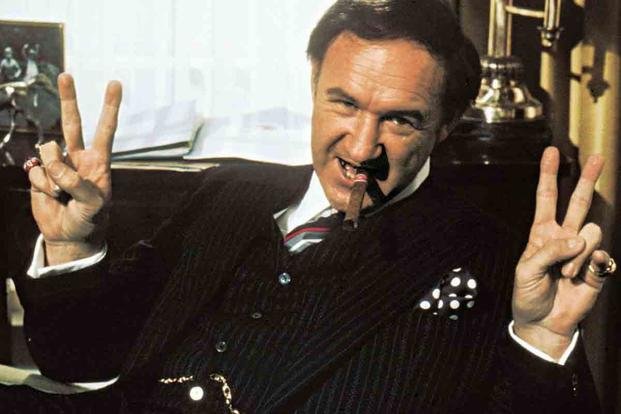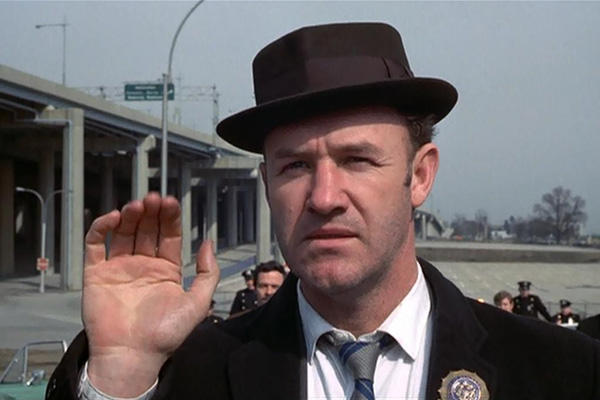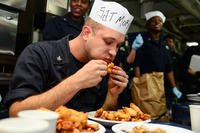"I have trouble with direction, because I have trouble with authority. I was not a good Marine."
Who Is Gene Hackman?
Gene Hackman, now retired but for six decades one of Hollywood's busiest and most respected actors, is known for films such as "The French Connection," "Bonnie and Clyde," "The Conversation," "The Royal Tenenbaums" and "Unforgiven."
A U.S. Marine Corps veteran who worked in journalism and odd jobs after his service, he didn't get into acting until he was over 30, and didn't become a big star until his late 30s.
He's the winner of two Academy Awards, for the 1971 action thriller "The French Connection" and the 1992 Western "Unforgiven."
He has also won four Golden Globes, one Screen Actors Guild Award, two BAFTAs, several film critic awards and other honors.
The Life of Gene Hackman
Born Eugene Allen Hackman in San Bernardino, California, on Jan. 30, 1930, when his parents were living there briefly with family members, he was raised mostly in Danville, Illinois.
His family had ancestral roots in the small town, about 80 miles northwest of Indianapolis. His grandfather, born in the region in the 1870s, was a newspaper reporter there in the 1930s and '40s.
Hackman's father, Eugene Sr., was a newspaper printing-press worker. His mother, Lyda, was Canadian, born in Ontario. His parents suffered a tragic loss a few months before Gene's birth, when they lost their son Joseph just days before the boy's first birthday.
Hackman was an only child until about age 13, when his brother Richard was born. As a young boy, he idolized Hollywood stars like James Cagney and Errol Flynn, and knew from about age 10 that he wanted to be an actor.
He has said his early life was troubled, that his mother turned to drinking and that his restless father abandoned the family for several years. He said he had little to no supervision or discipline from about age 12 on. This fostered a lifelong distrust of authority that manifested in conflicts during his military service.
He was married to Faye Maltese for 30 years, from the mid-1950s until the mid-1980s. They had three children together. He blamed their divorce in part on the intensity his film roles required, leaving him little time or energy to devote to his relationship.
In his downtime, his hobbies have included painting, drawing and boxing. He's also a novelist.
Hackman's demeanor has been described as small town, unpretentious and direct. Self-deprecating about his looks, he once described his face as "like mashed potatoes."
"He looks more like a coach than a movie star," the columnist James Brady wrote of Hackman soon after the release of "Hoosiers," in which the actor portrayed a small-town basketball coach.
Hackman has an adventurous streak. He used to race sports cars, go deep-sea diving and fly his own airplane. While in the Marines, he broke both legs in a motorcycle racing accident, which led to multiple surgeries and decades of pain.
Gene Hackman Military Service
Hackman's military service began when he was still a teen. At age 16, not long after his father left the family, he dropped out of high school and was lying about his age to join the Marines -- probably his first acting gig.
It took only a few months in 1947 for the teenage future award-winning actor to go from basic training at Parris Island, South Carolina, to a duty station in China. As he was bound for his station on a military transport ship, he rode out severe weather, possibly even a typhoon, in the Pacific.
While in Asia, he worked primarily as a radio operator. This turned out to be a great spot for Hackman, as he began playing disc jockey for the unit and eventually became a DJ for Armed Forces Radio in the Pacific. The stint turned into a longer-term position that included newscasting. Hackman's deployment took him from Qingdao to Shanghai, and he was later stationed in Hawaii.
Although he liked his new job, he was demoted repeatedly for leaving his duty station. During his time in the Marines, he also got into trouble for fighting and was demoted from the rank of corporal three times for leaving his post without permission.
"I have trouble with direction, because I have trouble with authority," he later recalled. "I was not a good Marine."
But he also said, "I had a good time in the Marines."
He served mainly with the 3rd Marine Regiment, according to Together We Served.
Hackman missed the Korean War due to the injuries from his motorcycle accident. By age 20, he was back home in Illinois, discharged as a disabled veteran.
These were Hackman's unit assignments, according to Together We Served:
- 1947: Signal School Battalion, San Diego
- 1947-48: Headquarters and Service Battalion, Marine Corps Base Camp Pendleton
- 1948-49: 3rd Marine Regiment
- 1949-50: Headquarters Battalion, 1st Marine Division
- 1950-51: 2nd Signal Battalion, 2nd Marine Division
- 1951: 2nd Reconnaissance Battalion
- 1951-52: Fleet Marine Corps Reserve
Related: To create a personalized transition plan, and for transition guides and checklists, visit the Military.com Transition Center.
Gene Hackman Movies and Acting Career
Once he left the military, Hackman moved back in with his parents, found work at a music store and used the GI Bill to study journalism and TV production at the University of Illinois.
He soon found his way back to California, and in 1957, he was a 27-year-old married man attending the Pasadena Playhouse acting school, lessons the GI Bill wouldn't pay for. He was a self-described "big lummox kind of person" surrounded by fit, tanned "walking surfboards." His best friend at the playhouse was another outsider, an odd-looking fellow with a big nose named Dustin Hoffman.
Their classmates at the Pasadena Playhouse voted them both "least likely to succeed."
Hackman received the lowest score in his acting class, but he refused to accept this assessment. Rejection only motivated him more.
"They said he had no talent whatsoever," Hoffman said of Hackman's acting in the Pasadena Playhouse. "He was so natural, they didn't think it was acting. He was that good."
Hackman and Hoffman later moved to New York with another close actor friend, Robert Duvall. Hackman worked a series of jobs -- such as soda jerk, furniture mover and shoe salesman -- to support himself, his career and his wife in the city.
While working as an NYC doorman, he encountered an officer from his days in the Marines. The officer called him a "sorry son of a bitch" who "wouldn't amount to anything." Hackman still refused to quit.
Hackman later joined the School of Radio Technique in New York, still on the GI Bill.
He eventually won roles on the New York stage in the 1960s, starting out with comedies. He was in his 30s at the time and began to find steady work that put him in the spotlight, but it was a struggle and it took him years to find his footing.
"It was more psychological warfare, because I wasn't going to let those f**kers get me down," Hackman told Vanity Fair. "I insisted with myself that I would continue to do whatever it took to get a job. It was like me against them, and in some way, unfortunately, I still feel that way. But I think if you're really interested in acting, there is a part of you that relishes the struggle."
For much of the 1960s, Hackman was playing small roles on television shows. It wasn't until his turn as Clyde Barrow's older brother in 1967's "Bonnie and Clyde," his first big movie role, that Hackman began to really embody a movie star. He was 37 years old. The role earned him his first Academy Award nomination for Best Supporting Actor.
By 1972, he had three Academy Award nominations, with one win for Best Actor for his role as Popeye Doyle in "The French Connection."
A prolific performer, Hackman has taken on dozens of lead and supporting roles, many of them tough guys and cruel characters. Especially early in his career, his trademark was portraying menacing, unpredictable men.
Popular Movies
After his breakthrough role, Hackman went on to star in Francis Ford Coppola's "The Conversation," play Gen. Stanisław Sosabowski in "A Bridge Too Far" and bring Lex Luthor to life in "Superman," all in the 1970s. His legendary roles include some of the most genre-defining movies ever, including "Hoosiers," "Unforgiven" and "The Birdcage," along with a seemingly unending list of film classics.

- "The Conversation" (1974): A chilling psychological thriller by writer/director Francis Ford Coppola. Hackman stars as Harry Caul, a taciturn San Francisco-based electronic surveillance expert who is hired to bug the private conversation of a young couple meeting in crowded and noisy Union Square, but who begins to fear for their lives and gets personally involved.
- "The French Connection" (1971): Portraying Jimmy "Popeye" Doyle, an angry and tough New York City narcotics detective who, with his partner, stumbles onto a French-based heroin smuggling ring but has trouble busting its leaders and stopping the flow of drugs into the U.S. Hackman's performance earned him the Oscar for best actor in 1972, along with several other awards.
- "The Royal Tenenbaums" (2001): Playing the title character, Royal Tenenbaum, a patriarch trying to make amends with his comically dysfunctional but genius family after abandoning them. "Hackman has the amazing ability to register belligerence, tenderness, confusion and guile within the space of a few lines of dialogue," The New York Times wrote in its review of the film.
- "Unforgiven" (1992): In this Clint Eastwood-directed Western, Hackman is Little Bill Daggett, a sheriff in 1880s Big Whiskey, Wyoming, who is sadistic yet a stickler for justice. Hackman won the Oscar in 1993 for best supporting actor.
- "Mississippi Burning" (1988): Hackman is Rupert Anderson, a redneck FBI agent sent to deeply segregated Mississippi -- his home state -- to investigate the reported disappearance of civil-rights workers in the 1960s.
- "Bonnie and Clyde" (1967): Takes on the role of Buck Barrow, the tweed-wearing deadly criminal who nevertheless provides comic relief as the goofy older brother of Clyde Barrow, the ex-con who goes on a nationwide violent-crime spree with waitress Bonnie Parker.
- "Crimson Tide" (1995): Plays Frank Ramsey, the short-tempered, trigger-happy captain of the U.S. nuclear submarine USS Alabama, who battles with the younger, better educated Cmdr. Ron Hunter (Denzel Washington) for control of the vessel while on war alert.
- "Night Moves" (1975): Stars as Harry Moseby, an old-school private investigator in 1970s Los Angeles, who is hired by a former Hollywood actress to find her runaway teen daughter, travels to Florida and stumbles upon murderous secrets.
- "The Firm" (1993): Portrays Avery Tolar, a law partner at a prestigious -- yet shady -- Memphis, Tennessee, firm who mentors a hotshot recent Harvard graduate (Tom Cruise).
- "Superman" (1978): Takes on the iconic role of Lex Luthor, the bald villain and real-estate mogul who battles the evil-fighting title superhero in the big city Metropolis.
- "Get Shorty" (1995): Flexes his comedy muscle in the starring role of Harry Zimm, a Los Angeles film producer indebted to the mob.
- "No Way Out" (1987): Plays David Brice, the U.S. secretary of defense, who becomes part of a love triangle when his mistress gets involved with a Navy officer under Brice's command.
- "Hoosiers" (1986): Considered one of the best sports dramas ever made, the film stars Hackman as Norman Dale, an angry, aging high school basketball coach who has a checkered past but is trying to make a comeback.
Movie descriptions adapted from IMDB.com.
Related: 10 Marine Corps Veterans Who Made It Big in the Movies
Is Gene Hackman Still Alive?

Gene Hackman is still alive and turned 94 years old in January 2024.
He retired from making films in 2004 and has come out of retirement only twice -- to provide narration for documentaries about Marine Corps history.
"I don't want to play great-grandfathers," Hackman told Time magazine. "And a lot of it is the stress of movie-making. You get a little older, and you don't like to get up at 5:30 in the morning. And night work. I hate night work."
Where Is Gene Hackman Today?
Soon after their relationship began in the mid-1980s, Hackman and his second wife, Betsy Arakawa, moved to Santa Fe, New Mexico, a quaint and beautifully artsy town that has drawn several movie stars seeking serenity.
Hackman hasn't made many public appearances in recent years. But in March 2023, he was spotted engaging in what appeared to be a typical day of an ordinary U.S. citizen: ordering a chicken sandwich from a Wendy's drive-thru, pumping gas, and later doing yard work on his property in Santa Fe, according to The New York Post.
Gene Hackman's net worth is estimated at $80 million, according to CelebrityNetWorth.com.
Want to Learn About More Famous Veterans?
Whether you want to learn more about other famous veterans, polish up your resume, find veteran job fairs in your area, or connect with employers looking to hire veterans, Military.com can help. Sign up for a free Military.com membership to have job postings, guides and advice, and more delivered directly to your inbox.













